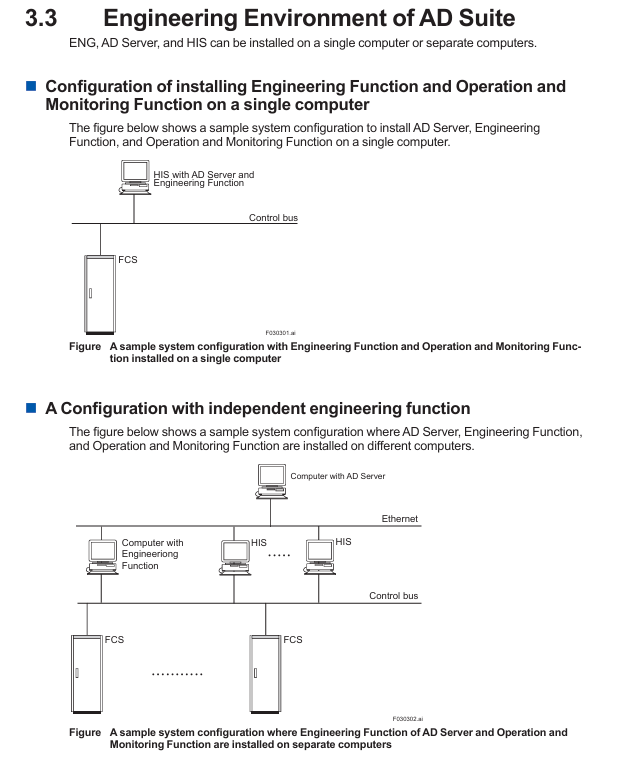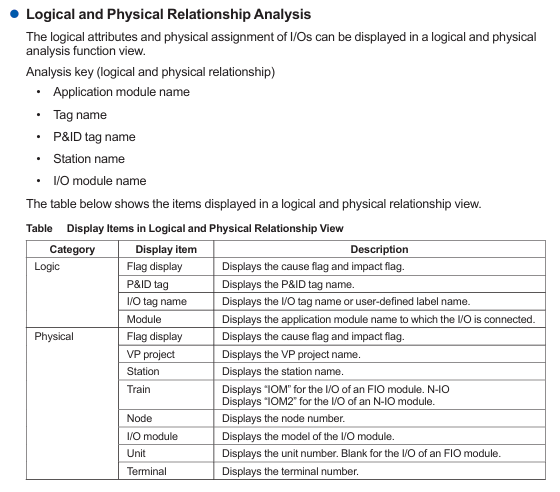YOKOGAWA CENTUM VP Integrated Production Control System (TI33J01A10-01EN)
The General Subsystem Gateway (GSGW) integrates subsystem data through OPC DA interface to achieve unified monitoring between subsystems and CENTUM VP.
The System Integrated OPC Station (SIOS) integrates third-party Process Control Systems (PCS) based on OPC interfaces to achieve bidirectional interaction between data and alarms.
The Unified Gateway Station (UGS/UGS2) integrates STARDOM controller and third-party PLC, supports OPC DA/A&E, Modbus, Ethernet/IP and other protocols, and can be dual machine redundant.
Advanced Process Control Stations (APCS) execute advanced control algorithms (such as Model Predictive Control) to improve factory operational efficiency.
Bus Converter (BCV) realizes communication relay between CENTUM VP and previous generation systems (such as CENTUM CS 3000, μ XL).
ProSafe RS T Ü V SIL3 certified safety instrumented system, responsible for emergency shutdown (ESD), fire and gas detection (F&G), burner management (BMS), seamlessly integrated with CENTUM VP.

Engineering Environment (AD Suite)
AD Suite is the core engineering environment of CENTUM VP, replacing traditional engineering tools of previous generation systems and supporting "centralized data management+flexible engineering methods". It consists of three major modules:
1. Core components
AD Server (Automated Design Server): 1 Centralized storage of engineering data (ADMDB database);
2. Manage project change history, support backup and recovery;
AD Organizer: 1 Modular engineering core tool, supporting module creation, instantiation, and batch editing;
2. View change history and dependency analysis results;
VP Builder: 1. Non modular engineering tools, including System View, Recipe View, etc;
2. Responsible for the engineering configuration of non FCS sites such as HIS and UGS.
2. Engineering methods
AD Suite supports two engineering methods to meet different project requirements:
Engineering method applicable scenarios, core processes
Scenario 1: Create a "class module" (template, including control logic, alarm properties, and design documents) for large-scale projects in modular engineering that require the reuse of historical experience;
2. Instantiate the "application module" (actual control unit);
3. Batch editing and binding hardware (I/O configuration can be modified later).
Scenario 1 for small projects without modular engineering and fixed hardware configuration: Firstly, determine the hardware configuration of FCS, I/O modules, etc;
2. Based on hardware design, control logic and I/O signal allocation;
3. Download directly to the website and run it.
3. Key functions (including standard and optional)
Standard features: No module engineering, change history management, AD Server/project management;
Optional features: 1 Modular engineering package: supports module creation and reuse;
2. Parameter tuning management: Compare design values with on-site values and issue parameters in batches;
3. Batch editing: tabular editing of control logic and alarm attributes, supporting consistency checks;
4. Change control: Manage the change process through ModPack forms (application analysis execution testing confirmation);
5. Dependency analysis: Analyze control logic I/O、 Assess the correlation between graphic labels and evaluate the scope of impact of changes.
Control Function (FCS)
FCS is the control core of CENTUM VP, responsible for the entire process of "data acquisition control calculation signal output", with the following core characteristics:
1. Hardware design
Compact layout: reduces equipment footprint, supports installation in IEC Zone2/Class I Div.2 hazardous areas, and lowers installation costs;
Redundant design: The processor, power supply, I/O module, and I/O network are all doubly redundant, with Active/Standby modules running synchronously and seamlessly switching in case of failure;
Flexible expansion: By expanding the number of I/O points through node units, it supports the mixed use of FIO (traditional I/O) and N-IO (software configured I/O) modules.
2. Software functions
Function Block Library: Provides monitoring, control (PID, etc.), calculation, logic, sequence control and other functional blocks, supporting conventional control, advanced control, batch control, etc;
Unit monitoring: defining multiple devices as "units" for unified operation and monitoring, adapting to batch processes and complex continuous processes;
Online maintenance: Support engineering stations to modify control logic and parameters without stopping the machine, and directly download them to FCS after modification without affecting on-site control.
3. Communication support
Supports multiple digital fieldbuses and third-party protocols to adapt to different smart devices:
Fieldbus: Foundation Fieldbus, HART, PROFIBUS-DP, PROFINET, DeviceNet, ISA100.11a wireless;
Universal protocols: Modbus RTU, Modbus TCP/IP, Ethernet/IP, IEC 61850 (for IED devices).

Security and integration capabilities
1. Integration with ProSafe RS (SIS)
Safety positioning: T Ü V SIL3 certification, used for ESD (emergency stop), F&G (fire and gas detection), BMS (burner management);
- EMERSON
- Honeywell
- CTI
- Rolls-Royce
- General Electric
- Woodward
- Yaskawa
- xYCOM
- Motorola
- Siemens
- Rockwell
- ABB
- B&R
- HIMA
- Construction site
- electricity
- Automobile market
- PLC
- DCS
- Motor drivers
- VSD
- Implications
- cement
- CO2
- CEM
- methane
- Artificial intelligence
- Titanic
- Solar energy
- Hydrogen fuel cell
- Hydrogen and fuel cells
- Hydrogen and oxygen fuel cells
- tyre
- Chemical fiber
- dynamo
- corpuscle
- Pulp and paper
- printing
- fossil
- FANUC
- Food and beverage
- Life science
- Sewage treatment
- Personal care
- electricity
- boats
- infrastructure
- Automobile industry
- metallurgy
- Nuclear power generation
- Geothermal power generation
- Water and wastewater
- Infrastructure construction
- Mine hazard
- steel
- papermaking
- Natural gas industry
- Infrastructure construction
- Power and energy
- Rubber and plastic
- Renewable energy
- pharmacy
- mining
- Plastic industry
- Schneider
- Kongsberg
- NI
- Wind energy
- International petroleum
- International new energy network
- gas
- WATLOW
- ProSoft
- SEW
- wind
- ADVANCED
- Reliance
- YOKOGAWA
- TRICONEX
- FOXBORO
- METSO
- MAN
- Advantest
- ADVANCED
- ALSTOM
- Control Wave
- AB
- AMAT
- STUDER
- KONGSBERG
- MOTOROLA
- DANAHER MOTION
- Bently
- Galil
- EATON
- MOLEX
- Triconex
- DEIF
- B&W
- ZYGO
- Aerotech
- DANFOSS
- KOLLMORGEN
- Beijer
- Endress+Hauser
- MOOG
- KB
- Moxa
- Rexroth


Email:wang@kongjiangauto.com






















































































































